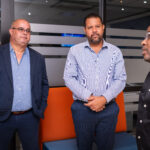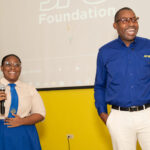(Kingston, October 14, 2024) Hundreds of primary and secondary school students attended phase two of the 11th staging of the Scientific Research Council’s (SRC) Young Inventors and Innovators Competition, the National Science and Technology Fair, held recently at Hope Gardens in Kingston. The event, powered by the JPS Foundation, featured exhibits from institutions across the island, where students showcased their innovative ideas to attendees and a panel of judges, and vied for prestigious awards.
Dr. Charah Watson, SRC’s Executive Director, expressed delight at the turnout from both urban and rural schools, citing that the fair shone despite the inclement weather:
“I am thrilled at the number of students who came out and braved the rain, but most importantly, I was blown away by their passion and interest in the subject matters they shared on,” she said. “They are way ahead of where I was at their age regarding finding a fix for some of our most common problems but also a few complex issues.”
The competition, which showcased the inventions and innovations of thirty-three schools, commenced with an Ideation Session, followed by a presentation of ideas to judges and culminated with an invite to shortlisted schools to participate in the National Science Fair.
Schools were also invited to participate through their Power Up Energy Clubs—a JPS Foundation initiative in high schools aimed at fostering creativity and innovation to address STEM-related challenges. With plans to expand these clubs to more secondary schools, the initiative reflects a growing commitment to nurturing young talent in science and technology.
Sophia Lewis, Head of the JPS Foundation, expressed her satisfaction with the students’ enthusiasm and ingenuity:
“STEM is alive and well. The level of thought that has gone into the ideas and presentations is testament to the fact that once students are given the platform to problem-solve and challenge themselves, they will rise to the occasion.”
TOP AWARDEES AT EDUCATIONAL LEVELS
In the primary school category, Free Hill Primary and Infant claimed the top spot with their project, Child Defense and Security Systems, which consists of devices and applications utilized to locate and track children as well as to organize rescue if they are in danger. Seaview Gardens Primary took second place with their innovative creation, Jack-oworl, a body scrub made from jackfruit while Corinaldi Avenue Primary secured third place with their project, Green Guard Adventures, aimed at instilling a sense of environmental responsibility among students through the creation of environmental protection tools.
Among secondary schools, St. Hilda’s Diocesan High emerged as the winner with their project, Ackeelizer, a three-in-one herbicide, pesticide and fertilizer made from ackee seeds. Manning’s School came in second with their concept, Learn Sphere, an educational platform designed to revolutionize the way students access learning resources and connect with expert tutors and York Castle High, through their Power Up Energy Club, took third place with their innovative power generating solution, Compressed Air Battery.
SPECIAL AWARDS
St. Hilda’s Diocesan High’s ‘Natural Lip Care Line’ v copped the Best Overall Pitch Award and the Best Commercial Innovation Award. The institution also walked away with the Best Innovation Award for their ‘Solar Electric Fence’ offering. The Best Use of Technology Award and the Best Youth Impact Innovation Award went to Manning’s School for ‘LearnSphere’. Immaculate Conception High was presented with the Best Agriculture Award for ‘Farma-Suitable’, an innovative solution that integrates a digital rain gauge, digital pH meter and sensors for measuring the oxygen and nitrogen content of soil into a single device.
Over the next couple of weeks, secondary schools, through their Power Up Energy Clubs, will have the opportunity to refine their presentations or come up with other ideas in order to pitch to STEM industry personnel and win prizes at the JPS Foundation Climate Expo which takes place on November 30.




